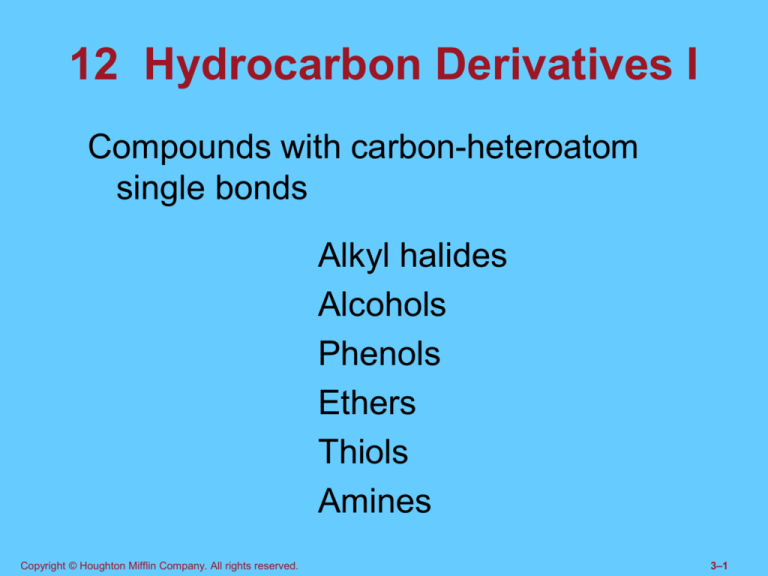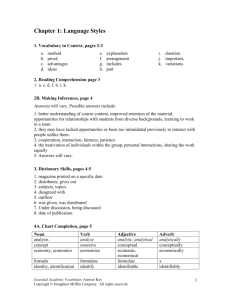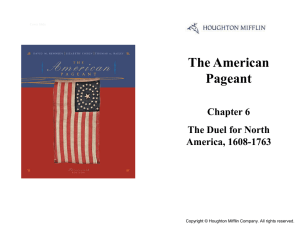
12 Hydrocarbon Derivatives I
Compounds with carbon-heteroatom
single bonds
Alkyl halides
Alcohols
Phenols
Ethers
Thiols
Amines
Copyright © Houghton Mifflin Company. All rights reserved.
3–1
12.2 Halogenated Hydrocarbons
Halogenated hydrocarbons have halogen
atoms (–F, –Cl, –Br, –I) on a hydrocarbon skeleton; R–X
H H H H
H C C C C Br
H H H H
1-bromobutane
Copyright © Houghton Mifflin Company. All rights reserved.
3–2
12.2 Naming Halogenated
Hydrocarbons
Halogens are treated as substituents,
like alkyl substituents. The prefixes
are fluoro–, chloro–, bromo–, iodo–.
H Cl
H C C Cl
H Cl
CH3
H3C C CH3
Br
1,1,1-trichloroethane
2-bromo-2-methylpropane
Copyright © Houghton Mifflin Company. All rights reserved.
3–3
12.2 Properties of Halogenated
Hydrocarbons
Many halogenated hydrocarbons are liquids
with densities greater than 1.00 g/mL.
Halogenated hydrocarbons are not very polar,
and are not soluble in water. They are good
solvents for hydrocarbons, and are used to
remove grease.
Halogenated hydrocarbons are not flammable,
and are used in fire extinguishers (halons).
Copyright © Houghton Mifflin Company. All rights reserved.
3–4
Common
Halogenated Hydrocarbons
Some halogenated hydrocarbons are used as
inhalation anesthetics.
H
Cl C Cl
Cl
F Cl
F C C H
F Br
trichloromethane,
a.k.a chloroform
2-bromo-2-chloro-1,1,1-trifluoroethane,
a.k.a halothane
Copyright © Houghton Mifflin Company. All rights reserved.
3–5
Common
Halogenated Hydrocarbons
Some halogenated hydrocarbons are used
as refrigerants. The chlorofluorocarbons
destroy atmospheric ozone. All are greenhouse gases.
F
Cl C F
Cl
F H
F C C H
F F
dichlorodifluoromethane,
a.k.a. R-12
1,1,1,2-tetrafluoroethane,
a.k.a. R-134a
Copyright © Houghton Mifflin Company. All rights reserved.
3–6
Common
Halogenated Hydrocarbons
Several halogenated hydrocarbons have been
used as pesticides. Many have adverse
environmental effects.
Cl Cl
H C Cl
C
Cl
Copyright © Houghton Mifflin Company. All rights reserved.
Cl
4,4'-(2,2,2-trichloroethane1,1-diyl)bis(chlorobenzene)
a.k.a. DDT,
dichlorodiphenyltrichloroethane
3–7
12.3 Alcohols
Alcohols have a hydroxy(l) group (–OH)
on an alkyl chain; R–OH
H
H
H
H
C
C O
H
H
H
H
C C
H
H C
C
C O
H
H
C
C C
H
C
H
H
Ethanol, Ethyl alcohol
Copyright © Houghton Mifflin Company. All rights reserved.
3–8
12.3 Naming Alcohols
1.
2.
3.
4.
5.
Suffix is “-ol”
Find longest chain that bears –OH
Number carbons on chain so carbon
bearing –OH has lowest possible number
Locate –OH by number of carbon
Locate and name any other substituents
Final “e” on name of hydrocarbon is
dropped.
Copyright © Houghton Mifflin Company. All rights reserved.
3–9
12.3 Naming Alcohols
Name these:
H H H H
H C C C C OH
H H H H
CH3
H3C C CH3
OH
Draw structures for:
2-methyl-1-propanol
Copyright © Houghton Mifflin Company. All rights reserved.
2-butanol
3–10
12.3 Naming Alcohols
Name this!
O
CH3
CH2
C
H
CH2
CH2
CH3
CH2
CH2
Copyright © Houghton Mifflin Company. All rights reserved.
CH2
CH2
CH3
3–11
12.4 Properties of Alcohols
Properties are driven by hydrogen
bonding and polarity.
Alcohols up with up to 6 carbons are
at least somewhat soluble in water.
Alcohols have higher melting and
boiling points than alkanes of similar
molar mass.
Copyright © Houghton Mifflin Company. All rights reserved.
3–12
12.4 Properties of Alcohols
Hydrogen bonding among alcohol molecules
Copyright © Houghton Mifflin Company. All rights reserved.
3–13
12.4 Properties of Alcohols
Copyright © Houghton Mifflin Company. All rights reserved.
3–14
12.4 Properties of Alcohols
As alkyl chain on alcohol gets larger, properties
become more alkane-like
Copyright © Houghton Mifflin Company. All rights reserved.
3–15
12.4 Properties of Alcohols
Melting and Boiling Points of Alkanes and Alcohols
400
Alkane MP, °C
Alkane BP, °C
Alcohol MP, °C
Alcohol BP, °C
Temperature, °C
300
200
100
0
-100
-200
0
5
Copyright © Houghton Mifflin Company. All rights reserved.
10
Number of Carbons
15
20
3–16
12.4 Properties of Alcohols
Classification of alcohols
Primary (1)
Secondary (2)
R
CH2
O
H
R1
CH O
H
R2
R1
Tertiary (3)
Copyright © Houghton Mifflin Company. All rights reserved.
R2 C O
R3
H
3–17
12.4 Reactions of Alcohols
Alcohols can dehydrate (lose H2O)
to produce alkenes.
H
H3C
H
H
C
C
H3C
O
H
C
H
H
H2SO4
180o C
H3C
C
C
C
H3C
H H
H
C
H
H
H
H
+
H
H
H
Major
C C
H
C
H H
Minor
C
H
+ H2O
Tertiary alcohols don’t react.
Copyright © Houghton Mifflin Company. All rights reserved.
3–18
12.4 Reactions of Alcohols
Alcohols can dehydrate to produce ethers
H3C
CH2
O
H3C
H
+ H O
CH2
O CH2
CH2
CH3
CH3
+
H2SO4
140o C
H2O
This is most useful with primary alcohols;
the alkene may also form.
Copyright © Houghton Mifflin Company. All rights reserved.
3–19
12.4 Reactions of Alcohols
Alcohols oxidize to form C=O bonds.
R1
R2
C O
H
[O]
H
R1
C O
+
H2O
R2
The reaction is formally loss of H2.
Oxidizing agents:
KMnO4, K2Cr2O7
Copyright © Houghton Mifflin Company. All rights reserved.
3–20
12.4 Reactions of Alcohols
Different classes of alcohol react differently.
Primary alcohols:
H
R
C O
H
O
[O]
H
R
C
O
[O]
H
Aldehyde
R
C
H
O
Carboxylic
acid
It can be hard to stop at aldehyde stage.
Copyright © Houghton Mifflin Company. All rights reserved.
3–21
12.4 Reactions of Alcohols
To make aldehyde, use CrO3 in pyridine.
Keep water out of the reaction!
H H
R C C O H
H H
Copyright © Houghton Mifflin Company. All rights reserved.
[O]
R
O
C
H
3–22
12.4 Reactions of Alcohols
Different classes of alcohol react differently.
Secondary alcohols:
R1
R2
C O
H
H
O
[O]
R2
C
R1
Ketone
Copyright © Houghton Mifflin Company. All rights reserved.
3–23
12.4 Reactions of Alcohols
Different classes of alcohol react differently.
Tertiary alcohols:
R1
R2
C O
H
[O]
No RXN
R3
Can’t react, no H on C!
Copyright © Houghton Mifflin Company. All rights reserved.
3–24
Common Alcohols
Methanol
Ethanol
CH3–OH
Wood alcohol; used
as solvent, reactant
CH3–CH2–OH Grain alcohol; used
as solvent, reactant,
beverage!
2-Propanol CH3–CH(OH)–CH3
Isopropanol
Rubbing alcohol; used
for sterilization of injection sites
Copyright © Houghton Mifflin Company. All rights reserved.
3–25
Common Alcohols
Ethanediol
Ethylene glycol
HO–CH2–CH2–OH
Antifreeze; poisonous
Cholesterol
Important biomolecule
CH3
CH3
CH3
H
H
H
O
Copyright © Houghton Mifflin Company. All rights reserved.
3–26
12.3 a Phenols
Alcohols have a hydroxy group on an
aromatic ring; –OH
H
H
H
C C
H
H C
C
C O
H
H
C O
C
H
H
C
C
C C
H
H
C
H
C
H
H
H
Phenol, a.k.a carbolic acid
Copyright © Houghton Mifflin Company. All rights reserved.
3–27
12.3 a Naming Phenols
Suffix is “phenol”
1. Carbon bearing hydroxyl is #1
2. Number carbons on ring so carbon bearing
substituent has lowest possible number
O
H3C
H
H
O
CH3
Cl
Copyright © Houghton Mifflin Company. All rights reserved.
3–28
12.3 a Naming Phenols
Phenols with several hydroxyls have cool names
OH
OH
HO
OH
OH
OH
Catechol
Resorcinol
OH
Hydroquinone
OH
OH
OH
OH
Pyrogallol
HO
OH
Phloroglucinol
Copyright © Houghton Mifflin Company. All rights reserved.
HO
OH
1,2,4 Benzenetriol
3–29
12.4 a Properties of Phenols
Properties are driven by hydrogen
bonding, polarity, and aromaticity
Most phenols are solids
Phenols are weak acids
Copyright © Houghton Mifflin Company. All rights reserved.
3–30
12.4 a Properties of Phenols
O
H
O
H
Copyright © Houghton Mifflin Company. All rights reserved.
3–31
12.4 a Reactions of Phenols
Phenols are weak acids and undergo acidbase reactions.
O
H
O
H
Phenoxide
anion
Copyright © Houghton Mifflin Company. All rights reserved.
+
H
O
H
Hydronium
cation
3–32
12.4 a Reactions of Phenols
Dihydroxyphenols oxidize to form quinones.
HO
OH
Hydroquinone
[O]
O
O
+ H2O
Benzoquinone
Hydroquinones are antioxidants; they react
with oxidizing agents and protect other compounds from oxidation.
Copyright © Houghton Mifflin Company. All rights reserved.
3–33
12.4 a Reactions of Phenols
Dihydroxyphenols oxidize to form quinones.
R
HO
O
O
[O]
OH
O
R
O
+
O
H2O
O
Vitamin C (ascorbic acid) acts like hydroquinone.
Copyright © Houghton Mifflin Company. All rights reserved.
3–34
Common Phenols
Phenol, a.k.a.
Carbolic acid
O
H
O
C
Salicylic acid
OH
OH
Disinfectant,
Local anesthetic
Analgesic, basis
for aspirin and
Ben-Gay
OH
Butylated
hydroxytoluene,
a.k.a. BHT
Copyright © Houghton Mifflin Company. All rights reserved.
Preservative,
antioxidant
3–35
Common Phenols
H3C
CH3
HO
OH
Used in epoxides and
polycarbonate plastics,
has estrogenic properties
Bisphenol-A
CH3 OH
H
H
A major component of
estrogen
HO
Estradiol
Copyright © Houghton Mifflin Company. All rights reserved.
3–36
12.5 Ethers
Ethers have oxygen atoms bonded
to two carbon atoms.
CH3
CH2
O
CH2
CH3
Diethyl ether
Copyright © Houghton Mifflin Company. All rights reserved.
3–37
12.5 Naming Ethers
Common names of ethers are formed by
naming the hydrocarbon group on either
side of the oxygen atom and adding the
word “ether.” The hydrocarbons are
named in alphabetical order.
CH3
CH2
O
Ethyl phenyl ether
Copyright © Houghton Mifflin Company. All rights reserved.
CH3
O
CH3
Dimethyl ether
3–38
12.5 Naming Ethers
Cyclic ethers have interesting names;
these turn up in carbohydrates.
O
H C
C H
C C
H
H
Furan
Copyright © Houghton Mifflin Company. All rights reserved.
H
H
O
C H
H C
H C C H
H
H
Tetrahydrofuran (THF)
H
H
C
C
O
C
C
C
H
H
H H
Pyran
3–39
12.5 Naming Ethers
Ethylene oxide and propylene oxide,
cyclic ethers with three-membered
rings, are important oddities. Such
ethers are called epoxides.
O
ethylene oxide
Copyright © Houghton Mifflin Company. All rights reserved.
O
CH3
propylene oxide
3–40
12.5 Naming Ethers
Cyclic di- and tri-ethers:
O
O
O
O
O
O
Dioxolane
Dioxane
Copyright © Houghton Mifflin Company. All rights reserved.
O
O
O
Trioxane
Dioxepane
3–41
12.5 Properties of Ethers
Ethers have boiling points similar to those of
hydrocarbons with similar structures.
CH3CH2OCH2CH3
CH3CH2CH2CH2CH3
Boiling point 35C
Boiling point 36C
Like hydrocarbons, they are flammable.
Copyright © Houghton Mifflin Company. All rights reserved.
3–42
12.5 Properties of Ethers
Ethers have water solubilities similar to those
of isomeric alcohols. They are hydrogen
bond acceptors.
Copyright © Houghton Mifflin Company. All rights reserved.
3–43
12.5 Reactions of Ethers
Ethers are not particularly reactive. They are
good solvents for certain reactions.
Ethers form explosive hydroperoxides in the
presence of oxygen. Ethers are treated
with antioxidants to prevent this.
H
H
O
C H
H C
H C C H
H
H
+
Copyright © Houghton Mifflin Company. All rights reserved.
O2
H
H
O
O H
C
C
H
O
H C C H
H
H
3–44
12.5 Reactions of Ethers
Polymeric ethers are made from ring-opening
reactions of epoxides, which are much
more reactive than most ethers.
CH3
HOCH2CH2OnH
HOCH2CHOnH
Poly(ethylene glycol) (PEG)
Carbowax
Poly(propylene glycol) (PPG)
Copyright © Houghton Mifflin Company. All rights reserved.
3–45
Common Ethers
Diethyl ether and chloroform were used as
anesthetics in the 1840’s. Fluorinated
ethers are not flammable and have fewer
side effects than either of these.
F F F
H
F
C
C
C
O
F
F
Cl
F Cl F
H
F
C
C
C
O
F
F
F
Enflurane
Isoflurane
Copyright © Houghton Mifflin Company. All rights reserved.
F H F
H
F
C
C
C
O
F
F
F
Desflurane
F F
F C H H
H
F
C
C
C
O
F
F
F
Sevoflurane
3–46
Common Ethers
Diethyl ether and tetrahydrofuran (THF) are
very useful solvents. Unlike most ethers,
THF is freely soluble in water.
CH3
CH2
O
CH2
Diethyl ether
Copyright © Houghton Mifflin Company. All rights reserved.
CH3
H
H
O
C H
H C
H C C H
H
H
Tetrahydrofuran (THF)
3–47
Common Ethers
Bisphenol-A diglycidyl ether (BADGE) is
the “resin’ in most epoxy glues.
H3C
CH3
O
O
O
Copyright © Houghton Mifflin Company. All rights reserved.
O
3–48
12.6 Thiols
Thiols are the sulfur analogs of alcohols.
The SH is called a sulfhydryl group.
R O
H
Alcohol
R S
H
Thiol
Another name for thiols is mercaptans,
from “mercury capture.” Thiols and
sulfide ions react with heavy metals.
Copyright © Houghton Mifflin Company. All rights reserved.
3–49
12.6 NamingThiols
Thiols are named like alcohols. The suffix
for the sulfhydryl group is “-thiol.” The -e
at the end of the alkane name is retained.
CH3 CH2 CH CH3
OH
CH3 CH2 CH CH3
OH
2-butanol
2-butanethiol
Copyright © Houghton Mifflin Company. All rights reserved.
3–50
12.6 Properties of Thiols
Thiols are polar, but are not capable of
hydrogen bonding.
Boiling points of thiols are lower than
those of analogous alcohols.
Small thiols are often have strong odors.
Copyright © Houghton Mifflin Company. All rights reserved.
3–51
12.6 Properties of Thiols
1-butanethiol is
added to natural gas as
an odorant,
so leaks can
be detected.
Skunk odor is
due to thiols.
Copyright © Houghton Mifflin Company. All rights reserved.
3–52
12.6 Reactions of Thiols
Thiols are weak acids and undergo acid-base
reactions.
CH3 CH2 S H + H2O
CH3 CH2 S H + OH1Р
ethanethiol
Copyright © Houghton Mifflin Company. All rights reserved.
CH3 CH2 S
+ H3O
CH3 CH2 S
+ H2O
thiolate anion
3–53
12.6 Reactions of Thiols
Thiols undergo oxidative coupling to form
disulfides.
R S H
+
H S R
thiols
[O]
R S S R + H2O
disulfide
This reaction is important in protein chemistry.
Copyright © Houghton Mifflin Company. All rights reserved.
3–54
12.6 Reactions of Thiols
Oxidative coupling is reversible. Reducing
agents, [H2], restore the thiols.
R S S R
[H2]
disulfide
R S H
+
H S R
thiols
These reactions are involved in “permanents”
and straightening agents for hair.
Copyright © Houghton Mifflin Company. All rights reserved.
3–55
12.7 Amines
Amines contain nitrogen. They are organic
derivatives of ammonia.
Copyright © Houghton Mifflin Company. All rights reserved.
3–56
12.7 Naming Amines
Common names of amines are formed by
naming the alkyl groups attached to the
nitrogen in alphabetical order and adding
the suffix “amine.”
CH3 CH2 NH2
ethylamine
CH3 CH2 N CH2 CH3
H
diethylamine
CH3
N
CH2 CH3
ethylmethylphenylamine
Copyright © Houghton Mifflin Company. All rights reserved.
3–57
12.7 Naming Amines
Aromatic amines are called anilines.
H
N
H
aniline
H
N
CH2 CH3
N-ethylaniline
H3C
N
CH3
N,N-dimethylaniline
The prefix “N-” locates alkyl groups on
nitrogen.
Copyright © Houghton Mifflin Company. All rights reserved.
3–58
12.7 Naming Amines
Cyclic aromatic amines with nitrogen in the
ring are common in biological molecules.
N
N
N
pyridine
N
N
pyrimidine
N
N
pyrazine
triazine
H
N
H
N
pyrrole
N
imidazole
Copyright © Houghton Mifflin Company. All rights reserved.
N
3–59
12.7 Naming Amines
Fused aromatic rings that contain nitrogen are
also common.
N
N
N
quinoline
Copyright © Houghton Mifflin Company. All rights reserved.
H
N
N
purine
3–60
12.7 Naming Amines
Aliphatic rings that contain nitrogen are also
common.
H
N
H
N
H
N
O
piperidine
N
H
piperazine
morpholine
H
N
pyrrolidine
N CH3
HO
Copyright © Houghton Mifflin Company. All rights reserved.
O
morphine
OH
3–61
12.8 Structures of Amines
Aliphatic amines have tetrahedral electronic
geometry and trigonal pyramidal molecular
geometry at the nitrogen atom.
R1
Copyright © Houghton Mifflin Company. All rights reserved.
N R
3
R2
3–62
12.8 Structures of Amines
Aromatic amines have trigonal planar electronic geometry and trigonal planar or angular
molecular geometry at the nitrogen atom.
N
H
N
The lone pair on pyrrole’s nitrogen is part of
the aromatic electron system.
Copyright © Houghton Mifflin Company. All rights reserved.
3–63
12.8 Properties of Amines
Amines are polar molecules. 1 and 2 amines
are hydrogen-bond donors. 3 amines are
hydrogen-bond acceptors.
Copyright © Houghton Mifflin Company. All rights reserved.
3–64
12.8 Properties of Amines
Nitrogen is less electronegative than oxygen,
so amines are less polar than alcohols.
Melting points and boiling points are lower
than those of alcohols of similar structure.
BP, C
Name
Formula
Methylamine
H3C NH2
-6.3
Methanol
H3C OH
65
Ethylamine
H3C CH2 NH2
17
Ethanol
H3C CH2 OH
78
Copyright © Houghton Mifflin Company. All rights reserved.
3–65
12.8 Properties of Amines
Aromatic amines follow the same trends.
MP, C
BP, C
C6H5 NH2
-6
184
C6H5 OH
41
182
Name
Formula
Aniline
Phenol
Amines with 6 or fewer carbon atoms are
at least somewhat water-soluble.
Copyright © Houghton Mifflin Company. All rights reserved.
3–66
12.8 Properties of Amines
Odors are prominent and unpleasant.
Small amines smell like ammonia.
Slightly larger amines smell like
dead fish.
H2N CH2 CH2 CH2 CH2 NH2
putrescine
H2N CH2 CH2 CH2 CH2 CH2 NH2
cadaverine
Copyright © Houghton Mifflin Company. All rights reserved.
3–67
12.8 Reactions of Amines
Amines are weak bases and undergo
acid-base reactions.
R 1 N R3
R2
+
R 1 N R3 +
R2
H2O
H3O1+
R1
H
N R3
R2
+
OH1
R1
H
N R3
R2
+
H2O
ammonium ion
Copyright © Houghton Mifflin Company. All rights reserved.
3–68
12.8 Reactions of Amines
Amines undergo alkylation when reacted
with alkyl halides.
R1 N R3
R2
+
R4Cl
R1
R4
N R3
R2
+
Cl1
Even tertiary amines do this. The products are called quaternary amine or
ammonium salts or just “quats.”
Copyright © Houghton Mifflin Company. All rights reserved.
3–69
Common Amines
Simple alkyl amines, e.g. methylamine,
have already been mentioned.
Amines from plants are called “alkaloids”
because they are basic. They often
have physiological effects.
OH
H3C
H
N
CH3
N
Nicotine, a stimulant
from tobacco
Copyright © Houghton Mifflin Company. All rights reserved.
O
N
CH3
N
N
N
CH3
Caffeine, a stimulant
from coffee and tea
3–70
Common Amines
The “bases” in DNA and RNA are amines.
They interact by hydrogen bonding.
Adenine O
H
H
N
N
H
N
N
N
sugar
N
CH3
Guanine
H
N
O
Thymine
Copyright © Houghton Mifflin Company. All rights reserved.
H
N
O
sugar
N
N
sugar
N
N
N
H
N
sugar
O
H Cytosine
N
H
3–71



